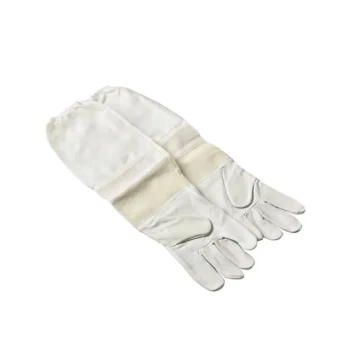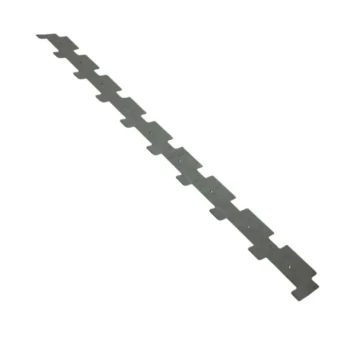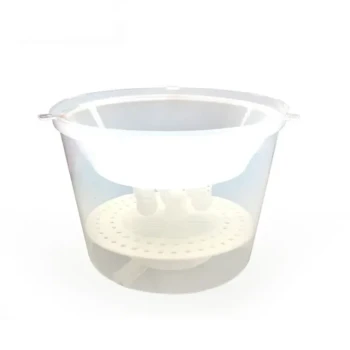When selecting beekeeping gloves, the most critical factors to evaluate are material, fit, and cuff length. These three elements work together to define the glove's performance, forcing a direct trade-off between sting protection and the dexterity needed to work safely and gently with your bees. Understanding this balance is the key to choosing the right glove for your specific needs.
The ideal beekeeping glove does not exist. Your goal is to find the right compromise between maximum protection and maximum dexterity, a choice that will evolve with your experience and the temperament of your hives.
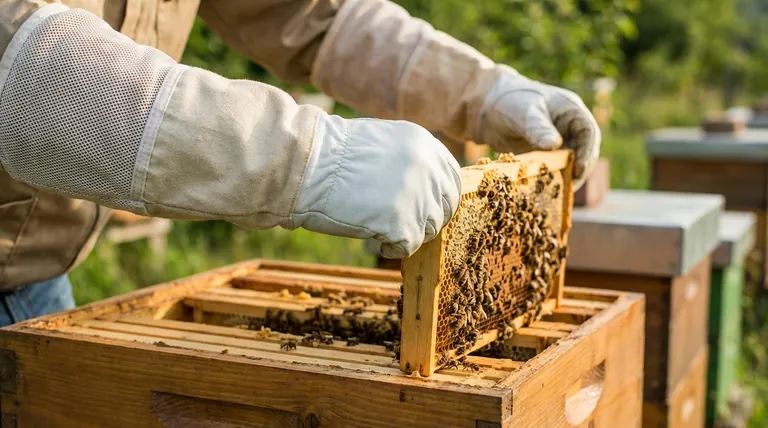
The Core Conflict: Protection vs. Dexterity
Every decision about beekeeping gloves comes down to balancing two opposing needs. Misunderstanding this conflict is the most common mistake new beekeepers make.
The Need for Protection
Your hands are the most exposed and active part of your body during a hive inspection. Gloves serve as the primary barrier against stings on your hands, wrists, and forearms.
High-quality gloves use thick materials and feature long cuffs with elastic seals. This design prevents bees from getting underneath your suit, which is a common cause of stings.
The Importance of Dexterity
While protection is crucial, a lack of "feel" can be dangerous in its own right. Bulky, ill-fitting gloves make it difficult to handle frames, cages, and the bees themselves.
This lack of control increases the risk of dropping equipment or, more importantly, accidentally crushing bees. Agitated or injured bees release alarm pheromones, which can quickly escalate the defensive behavior of the entire colony.
Deconstructing the Glove: Key Selection Factors
To find your ideal balance, you must analyze how each component of the glove contributes to protection and dexterity.
Material: The Foundation of Your Choice
The material dictates the fundamental properties of the glove.
- Cowhide Leather: This is the thickest and most protective option. Its dense structure is highly resistant to stings, making it a common choice for beginners who prioritize safety above all else. However, it offers the lowest dexterity.
- Goatskin: Widely considered the best all-around material, goatskin is thinner and more supple than cowhide. It provides a good balance, offering reliable sting protection while allowing for significantly more feel and control.
- Nitrile: These are disposable, medical-style gloves. They offer virtually no sting protection but provide maximum dexterity. They are only suitable for highly experienced beekeepers working with calm colonies or for very delicate tasks.
Fit: The Key to Control
A proper fit is non-negotiable for both safety and effectiveness.
The glove should be snug, like a second skin, but not tight enough to restrict circulation. Excess material at the fingertips will fold and catch, reducing your ability to perform precise movements and increasing the chance you'll crush a bee.
Cuff Length and Seal
Protection doesn't stop at the wrist. Beekeeping gloves must have long cuffs that extend to or past the elbow.
Look for a strong elastic seal at the end of the cuff. This ensures a tight overlap with your bee suit or jacket, creating a secure barrier that prevents bees from crawling inside.
Understanding the Trade-offs
There is no single "best" glove, only the best glove for a specific philosophy and experience level.
Thick Leather: Maximum Protection, Minimal Feel
Choose thick cowhide gloves if you are a new beekeeper, are known to be highly allergic, or are working with an aggressive or unknown hive. You sacrifice dexterity for peace of mind.
Goatskin: The Balanced Approach
For most beekeepers, goatskin is the optimal choice. It provides enough protection to build confidence while retaining enough dexterity to work gently and efficiently. This is the workhorse glove for day-to-day inspections.
Nitrile: Ultimate Dexterity, Minimal Protection
Reserve nitrile gloves for specific, delicate tasks like queen marking or grafting larvae. Using them requires a deep understanding of bee behavior and a very calm, confident approach to beekeeping.
Making the Right Choice for Your Goal
Evaluate your primary need to select the most effective tool for the job.
- If your primary focus is maximum safety as a new beekeeper: Choose a well-fitting pair of thick cowhide or goatskin gloves with long, elasticated cuffs.
- If your primary focus is balance for routine inspections: Select a high-quality, supple goatskin glove that fits snugly.
- If your primary focus is ultimate dexterity for advanced tasks: Use thin nitrile gloves, but only if you are an experienced beekeeper confident in your skills and the temperament of your bees.
Choosing the right glove empowers you to be a more effective, confident, and gentle beekeeper.
Summary Table:
| Factor | Key Consideration | Impact on Beekeeping |
|---|---|---|
| Material | Cowhide, Goatskin, or Nitrile | Dictates sting protection vs. dexterity |
| Fit | Snug but not restrictive | Ensures control and prevents bee crushing |
| Cuff Length | Extends to elbow with elastic seal | Blocks bees from entering suit |
Equip Your Apiary with Confidence
Choosing the right gloves is just the first step. At HONESTBEE, we supply commercial apiaries and beekeeping equipment distributors with the durable, high-performance gear needed for safe and efficient operations. Our wholesale-focused model ensures you get the best value on reliable equipment that protects your investment and your bees.
Contact our team today to discuss your wholesale needs and discover the HONESTBEE difference.
Visual Guide
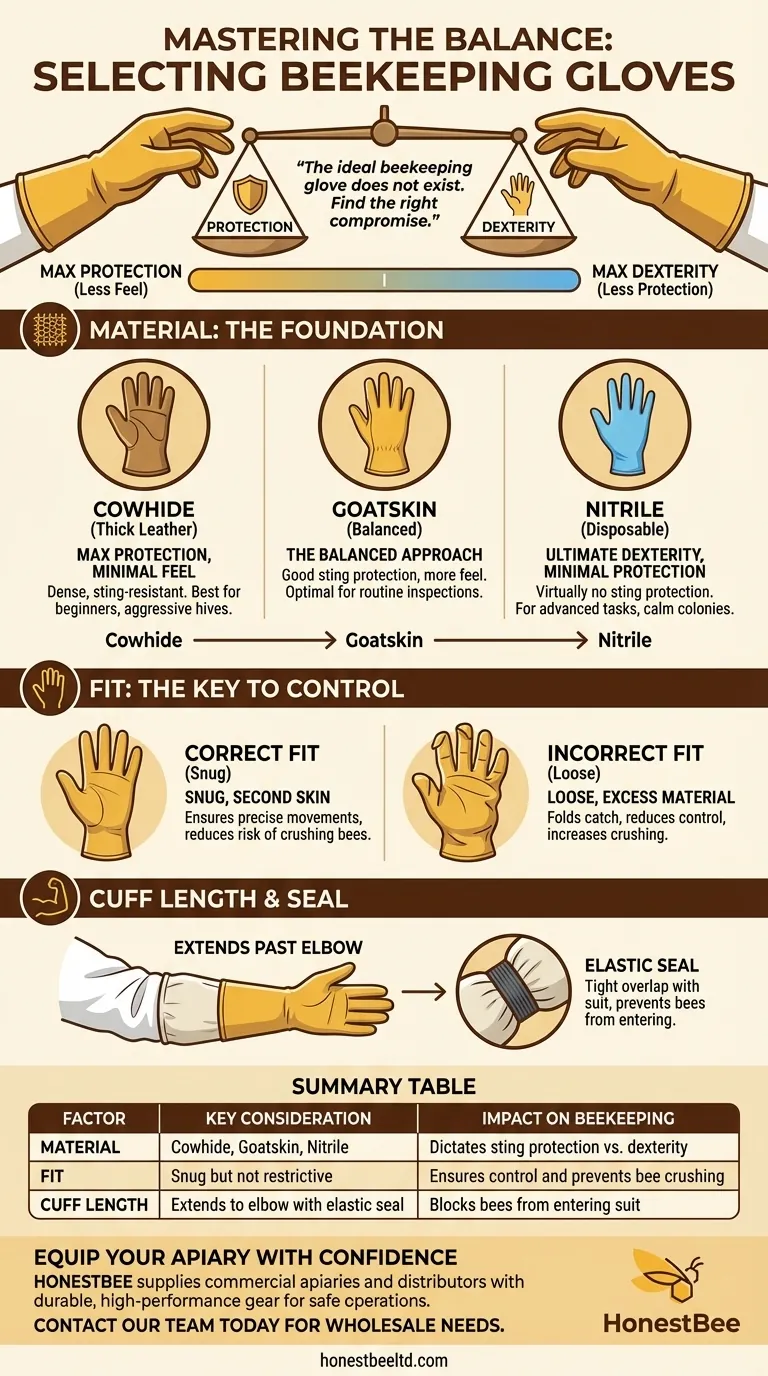
Related Products
- Goatskin Leather Beekeeper Gloves with Vent Long Sleeve for Beekeeping Honey Bee Sting Proof Protection
- Mesh Ventilated 3 Layer Goatskin Beekeepers Gloves for Beekeeping
- Goat Skin Leather Bee Sting Proof Beekeeping Gloves with Canvas Sleeve
- Professional Galvanized Hive Strap with Secure Locking Buckle for Beekeeping
- Metal Queen Bee Excluder for Beekeeping
People Also Ask
- How can you wash beekeeping gloves? A Guide to Preserving Your Gear & Hive Health
- How do beekeeping gloves help in maintaining hygiene? Essential for Hive Biosecurity
- What are the characteristics of beekeeping gloves? Balancing Sting Protection with Dexterity
- Why is it important to have gloves available even if not always worn? Essential Risk Management for Beekeepers
- What should beginner beekeepers consider when choosing beekeeping gloves? Balance Protection and Dexterity for Success
